

[ SUNDAY TRAVEL ]

Friends, MY STYLE of travel is to watch for road signs. I'm puzzled though that in 26 years of visiting Hawaii, I have never received a road advisory for Waianae.
food and kava
in Waianae
A heiau, a whale, surf, horses
and green valleys surface on
a jaunt to rural OahuBy Sweet William
Special to the Star-BulletinOn all my previous visits to Oahu, starting in '77, no one ever mentioned it.
The road to Waianae, I soon learn, is a dead end. No one talks about Waianae without frowning. I decide to follow up on an opportunity to visit a local family, knowing I wouldn't otherwise get a chance to understand Waianae.
I take TheBus. I notice two things about the Waianae coast. More empty green valleys and a lot of people living on the beach and not just for the weekend. In Nanakuli, there are about 30 people on the beach; it looks like an ancient fishing village. In a strange way, they remind me of the hippies of the late '60s and early '70s, living on the beaches of Kauai, Maui and the Big Island.
My hosts pick me up at Longs Drugs and we head up into Waianae Valley, which is not empty, nor is it green. Richard is a fisherman; his wife, Lorraine, a high-school teacher; their daughter Malina, the center of their universe.
The food production at their house never stops; it's like the cruise ship. Friends arrive all afternoon and into the evening. Lorraine serves and Richard cooks. Later, after all the women and children have disappeared, yet another friend arrives. He's carrying a white plastic bucket, a paper sack and a bottle of water.
"Awa," the men cheer. He prepares the mixture and in due time I have my first kava experience. My lips get numb, I get buzzed and we all tell our stories. Much conviviality emerges from the kava. It doesn't take a research scientist to realize kava is a much healthier beverage than beer. Maybe that's why it has become one of Hawaii's fastest growing agricultural products.
In the morning, my hosts take me on a tour of the Leeward Coast. Where Makua Valley meets the ocean, Richard grumbles, "This valley is used for artillery practice."
Lorraine adds, "The Ogden Survey done for the Army has identified various cultural sites hundreds of years old. It's quite controversial whether the military should continue artillery firing in the valley."
Next stop is a big cave on the mauka side of the road. Inside the 30-foot-high entrance, Richard points to a small opening and recalls that when he was younger he and his pals would follow the tube 200 feet to where it exits the cliff above the ocean.
Makaha Beach sports one of the great Hawaiian surf breaks. Many big tournaments make their way from the North Shore to Makaha. We drive up Makaha Valley, site of the failed Sheraton Resort, which is now just a golf course. Malina loves playing with the resident ducks. Eight-story condo buildings dot the valley walls with their rectangular shapes. Richard observes, "We have lost this valley."
Our next stop is Waianae Boat Harbor. Richard's brother Leonard, a night scuba fisherman, is working on their fishing boat. At Pokai Bay we walk out past the jetty to the heiau where Richard and Lorraine were married. The surf pounds away at the lava rock. The heiau's low walls, although weathered, outline a site that still commands great importance.
As we drive along the coast, Richard points out a passing whale less than 50 yards from shore. We pass a shuttered Shell station, a shuttered Chevron. I ask them, What sells well in Waianae?
Lorraine says, "Food."
We stop along the roadside to feed the horses some grass. We're in rural America.
Back at their middle-class home in Waianae, Richard takes me out back to show me six Mgambo trees, hua weleweka, that he cultivated from seeds. He picks some of the black velvety seeds and hands them to me, "People make these into leis," he says.
In the house, Richard lays several seed necklaces on the table. "Over in Hilo for the Merrie Monarch these Mgambo bead leis sell for hundreds of dollars. I want to learn how to make them."
In the kitchen while washing some pots, I ask Lorraine if she sees signs at Waianae High School of the renaissance in all things Hawaiian. "We have a terrific Hawaiian Cultural Studies program," she replies proudly. "It has Hawaiian language instruction; students go on archeological digs; they make art in class, build ukuleles, learn ancient arts."
When asking a teacher about her work, you'd better have a good supply of pots and pans to wash. Teachers have a lot to say about education.
The next morning, as I prepare for my return to Diamond Head, Richard asks me if I would like to take back some fish. "Sure," I say, and he hands me a huge chunk of marlin.
I barbecue the fish at the Diamond Head Beach Hotel as the sun sets.
Several hotel employees come by for a taste. Mr. Aloha from the Outrigger Canoe Club also comes by. Everyone is most appreciative of the Waianae fisherman named Richard. No doubt his generosity will not be forgotten by those who tasted that marlin -- powerful fish, powerful food, powerful feeling.
I now realize the reason no one in Honolulu speaks about Waianae is that they're embarrassed. Hawaiian culture seems to hold more promise for Waianae than does the city. "Aloha ia o Waianae" is on a different path than that which Honolulu travels.
>> Next: Punalu'u: Remembering 97 year-old Margaret Na'ai.
Sweet William is a paradise writer and Eden experimenter.